Ultraviolet LED has the advantages of small specific product, long life and high efficiency, and has broad application prospects. At present, the luminous power of the ultraviolet LED is not high, and in addition to the improvement in the level of chip fabrication, the packaging technology also has an important influence on the characteristics of the LED.
Currently, UV LEDs are mainly available in epoxy and metal and glass lens packages. The former is mainly applied to near-ultraviolet LEDs of around 400 nm, but ultraviolet light has a great influence on the aging of materials. The latter is mainly applied to ultraviolet LEDs with wavelengths less than 380 nm. Since GaN and sapphire have refractive indices of 2.4 and 1.76, respectively, and gas refractive index is 1, a large refractive index difference causes total reflection to be more restrictive to light. Light extraction efficiency is low.
Packaging materials are another important aspect of LED packaging technology. LED packaging materials mainly include glass lenses, epoxy resins and silicone resins. Quartz glass softening point temperature is 1 600 ° C, hot processing temperature is 1 700 ~ 2000 ° C, from the process point of view, quartz glass is not suitable for sealing LED chips; epoxy resin high temperature heat resistance, general ultraviolet light resistance Silicone resin has been applied to LED packaging materials in recent years. At present, there are few studies on the transmittance, heat resistance and ultraviolet light resistance of silicone resin in China, especially for the characteristics of silicone packaged UV LED.
Based on the packaging technology of UV LEDs with wavelengths less than 380 nm, this paper compares the transmittance, UV resistance and heat resistance of different packaging materials, and then proposes an ultraviolet LED package structure with high light efficiency and high reliability.
experiment
The UV LED chips used have peak wavelengths of 395 and 375 nm, which are prepared by epitaxially growing GaN on silicon carbide and sapphire substrates. At 20 mA injection current, the L ED chips of silicon carbide and sapphire substrates operate at 3.8 and 3.4 V, respectively.
Five different types of packaging materials, including quartz glass, epoxy resin and silicone resin, were studied. Quartz glass is a JGS1 material with a thickness of 2 mm; epoxy resins A and B are bisphenol A and alicyclic epoxy, respectively; silicones A and B are elastic silica and resin silica, respectively.
The optical power and peak wavelength were measured on the PMS-50 enhanced UV-Vis-NIR spectroscopy system of Hangzhou Yuanfang Company. The optical transmittance measurement system is shown in Figure 1. The monochromator is the CM200 type of Jiangsu Weixin Technology Co., Ltd., the light source is the GY-10 high-pressure spherical xenon lamp of Tianjin Top Co., and the signal acquisition and processing system is far away. The company's UV-Vis analysis system.
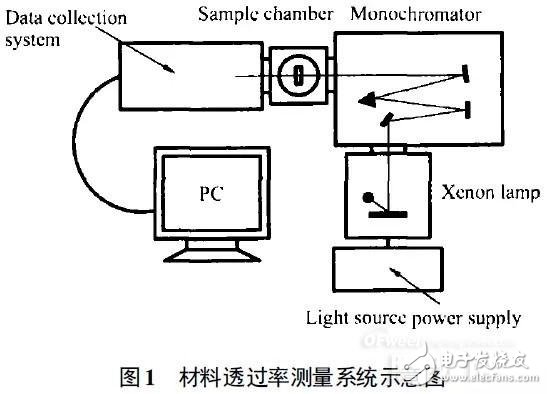
The thermal stability of the material was evaluated as a function of time. The sample has a thickness of 2 mm and is placed in an oven at a constant temperature and temperature of 150 °C.
UV LED packaging materials research
1. Material optical transmittance characteristics
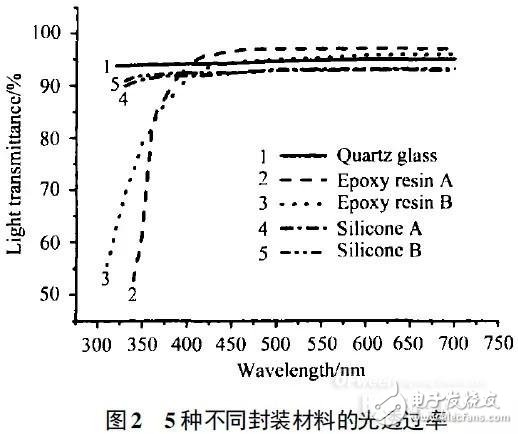
The transmittance of quartz glass, silicone and epoxy is shown in Figure 2. Silicone and epoxy resin are first injected into the mold, and after high temperature curing, the mold is released to form a sample having a uniform thickness of 5 mm. For comparison, the measured values ​​are converted to the transmittance at a thickness of mm-1 according to Bouguer-Lam-bert's law.
It can be seen that the epoxy resin has a high transmittance in the visible light range, and the transmittance of some wavelengths even exceeds 95%, but the absorption loss of the epoxy resin in the ultraviolet light range is large, and when the wavelength is less than 380 nm, The penetration rate has dropped rapidly. The transmittance of silicone in the visible range is close to 92%, slightly lower in the ultraviolet range, but still higher than 88% at 320 nm, showing good UV transmission properties; quartz glass in the visible and ultraviolet range The transmittance is close to 95%, which is the highest UV transmittance of all materials.
For UV LED packages, quartz glass has the highest transmittance, followed by silicone and epoxy. However, although quartz glass has a high transmittance of ultraviolet light, its high heat processing temperature is not suitable for the sealing of the LED core region, and therefore quartz glass is generally used only as a lens material in the LED packaging process. Due to the high ultraviolet radiation resistance and heat resistance of quartz glass, there have been many reports on the ultraviolet radiation resistance and heat resistance of epoxy resins and silicone resins commonly used for sealing LED core regions.
2, UV resistance
The aging of epoxy resins A and B and silicone resins A and B at 395 nm and 375 nm LED chips was investigated, as shown in Figure 3. In the experiment, the resin coating thickness of each LED was 2 mm.
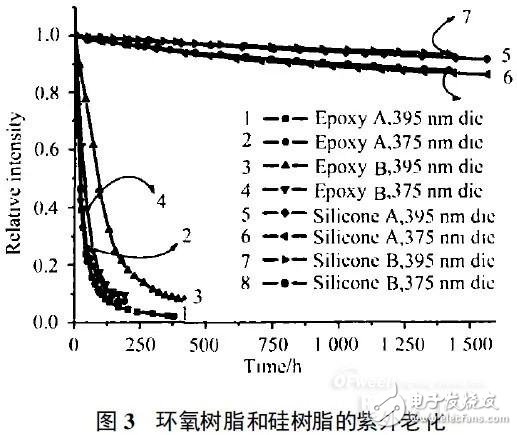
It can be seen that the epoxy resin has poor ultraviolet radiation resistance. When working continuously, the output power of the UV LED is rapidly attenuated. After 100 hours, the output optical power drops below the initial 50%; after 200 hours, the LED output light The power is already very weak. For the alicyclic epoxy resin B, the attenuation at 375 nm is faster than that at 395 nm, indicating that it is sensitive to the wavelength of ultraviolet light, and the damage is also more serious due to the large photon energy of 375 nm.
The bisphenol epoxy resin A decays rapidly under ultraviolet light of 375 nm and 395 nm, and the decay rate is basically the same. Although the bisphenol-based epoxy resin A has a light transmittance at 375 nm and 395 nm which is slightly higher than that of the alicyclic epoxy resin B, since the epoxy resin A contains a benzene ring structure, it is continuously irradiated with ultraviolet light. The attenuation is faster than epoxy B. The optical power of the LED chip before and after aging was measured, and it was found that the optical power of the LED after aging was substantially not attenuated.
This shows that the attenuation of optical power is mainly caused by the destruction of epoxy resin by ultraviolet light. Epoxy resin is a polymer material. Under ultraviolet light, the polymer absorbs ultraviolet photons, and the ultraviolet photon photon energy is large, and the bond between the polymers can be opened. Therefore, under continuous ultraviolet light irradiation, the main chain of the epoxy resin is slowly destroyed, resulting in degradation of the main chain, photodegradation reaction, and changes in properties. Experiments show that epoxy resin is not suitable for the packaging of UV LED chips with wavelengths less than 380 nm.
Compared with epoxy resin, silicone resin exhibits good UV resistance. After nearly 1500h aging, although the LED output optical power has different degrees of attenuation, it still maintains above 85%, and the attenuation is less than 15%. This may be related to structural differences between silicone and epoxy. The main structure of silicone resin includes Si and O. The main chain Si-O-Si is inorganic and has a high bond energy (422.5 kJ/mol). The main chain of epoxy resin is mainly CC or CO. They are 356kJ/mol and 344.4 kJ/mol, respectively. Due to the higher bond energy, the performance of the silicone resin is relatively stable. Therefore, the silicone resin has good ultraviolet light resistance.
3, heat resistance
LED packaging places higher demands on the heat resistance of materials. As can be seen from Fig. 3, epoxy resin B and silicone resin B have better ability to withstand ultraviolet light irradiation. Therefore, its thermal stability was studied. Figure 4 shows the change in transmittance of these two materials over time at a thickness of mm-1 after high temperature aging. It can be seen that the heat resistance of the epoxy resin is poor. After high temperature aging for 6 days, the transmittance of each wavelength is greatly attenuated, and the attenuation of the ultraviolet light range is particularly serious. The initial clearness turned into a tan.

Silicone exhibits excellent heat resistance. In the high temperature environment of 150 °C, after 14 days of aging, the transmittance of the sample in the visible range is only slightly attenuated at the thickness of mm-1, and there is only a small amount of attenuation in the ultraviolet range, and the color remains initially clear. Transparent. Unlike epoxy resins, silicone resins have Si-O-Si bonds as the main chain, and Si-O bonds have excellent heat resistance due to their high bond energy and ionization tendency.
High light efficiency, high reliability UV LED package
According to the experimental results, combined with silicone resin and quartz glass material, a new UV LED packaging method is proposed, as shown in Figure 5.
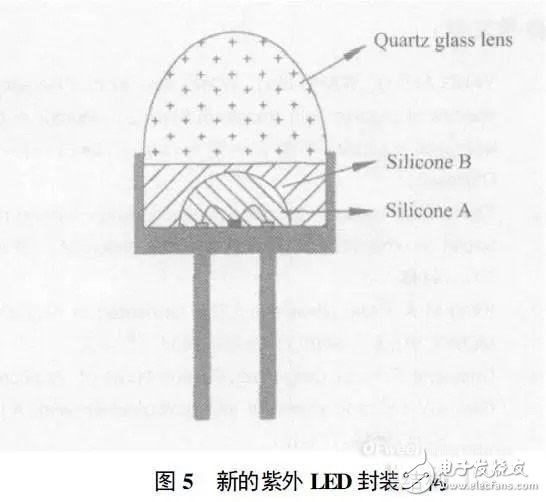
The package structure has 3 layers. The inner layer is sealed with silicone resin A. Because the refractive index of silicone resin A is 1.53, it is beneficial to fully improve the extraction efficiency of LED, and it is elastic silica gel after curing. The lower mechanical strength is beneficial to protect the chip and electrode leads. The intermediate layer is silicone resin B, which acts as a transition layer between the quartz glass lens and the silicone resin A layer, and the silicone resin B has a high transmittance and a refractive index of 1.51; the hardness after curing is high and the adhesion is good, and the adhesion is good. Fixed glass lens. The outer layer is a high transmittance JGS1 quartz glass lens with a refractive index of 1.46, which is used for light extraction and forms a certain light field distribution. Its extremely high UV transmittance reduces light during lasing. Loss.
In the entire structure, in order to minimize the absorption loss of ultraviolet light by the silicone resin, the thickness of the resin layer is thin. At the same time, the three-layer structure with decreasing refractive index layer by layer is beneficial to reduce the Fresnel loss of light during propagation.
The table below shows the optical power before and after the UV LED package in different package configurations.
It can be seen that in the case of the same peak wavelength of the LED chip and the similar power of the die, the ultraviolet LED of the new package structure has an output power increase of more than 60%, and the light extraction efficiency is 2.7 times that of the metal and glass lens package. Compared to epoxy-encapsulated UV LEDs, the UV efficiency of the new package structure is lower, but the stability is much better than that of epoxy-encapsulated LEDs. The aging experiment shows that the ultraviolet LED light-emitting power of the epoxy resin package has been attenuated to less than 50% in less than 100 hours. The UV LED of the new package structure has good stability. After 800 hours of continuous operation, the luminous power is still maintained above 95%, and the luminous power attenuation is less than 5%.
in conclusion
Silicone resin has higher UV transmittance, better UV resistance and heat resistance than epoxy resin, and is a good material for sealing UV LED chips. An ultraviolet LED packaging method using a silicone and quartz glass lens package was designed.
The UV-emitting efficiency of the new package structure is 2.7 times that of the metal case and the glass lens package LED; at the same time, it has good stability, continuous operation for 800h, and the luminous power attenuation is less than 5%.
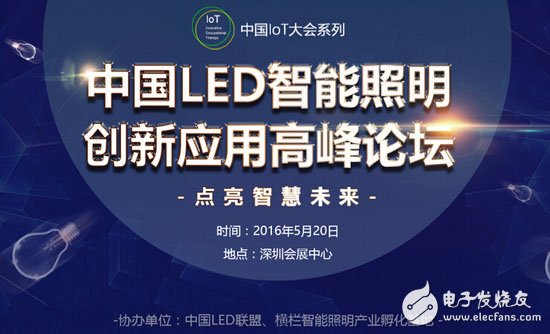
China IOT Conference Series [The 3rd China LED Intelligent Lighting Innovation Application Summit Forum ] will invite Zigbee Alliance, WiFi, Bluetooth and 2.4G technology major supplier executives to share their market insight and latest development results, I hope you can grasp This rare opportunity to exchange, find better business opportunities, and find a higher partner.
Esd Cleanroom Foam Swab,Esd Knitted Polyester Swabs,Esd Polyurethane Foam Swab,Esd Long Foam Swab
Miraclean Technology Co., Ltd. , https://www.mrccleanroom.com